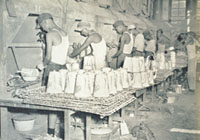| In 1951, The United Nations
placed an embargo on trade against China. Following
the instruction of the United Kingdom, Hong Kong ceased
to do business with Chinese Mainland. The entreport
trade of Hong Kong, which had just resumed and developed
after the war, was seriously disrupted and Hong Kong
had to undergo economic transformation. Making
use of the capital, labour force and industrial expertise
from the Chinese Mainland, and capitalizing on the
extensive market connections of their own, Hong Kong
manufacturers imported a great quantity of cotton
to produce semi-product and finished goods and then
sold them to the United States, the United Kingdom,
Australia and the Southeast Asia countries, resulting
in the rapid growth of the textile industry.
Along with the growth of the
textile industry, the number of registered textile
factories in 1960 increased to 826, employing some
62,000 persons. During the same period, there
were 689 garment factories, employing approximately
42,000 workers. The textile and clothing industry
together accounted for more than 40% of the total
manufacturing workforce. At the same time, other
industries such as the footwear, hand gloves, torches
and bulbs, vacuum flasks, enamelware, aluminiumware
and rattanware also began to establish and develop.
According to statistics, there were 2,284 registered
factories in Hong Kong in 1954, hiring 109,997 persons.
By 1959, the number of factories had increased to
4,689 and the number of workers risen to 205,726,
both representing an increase of approximate 100%.
In 1960, Hong Kong's domestic
exports reached HK$2,860 million, accounting for some
72% of the total exports. This marked the transformation
of Hong Kong from a trading entrepot to a manufacturing-oriented
industrial city. |
 Durable, washable and indistinguishable from
the real thing, plastic flowers made in Hong Kong
sold well in many parts of the world.

In 1954,
half a million people in Hong Kong walked on wooden
shoes (clogs) called "Mook Kek" - a name which sounds
like their click-clack rattle on the city streets.
In the photograph, an artist was applying ornament
to a pair of "Mook Kek".

Enamelware was once one of Hong Kong's most
active industries with the widest markets. The
workers were painting designs on enamelware.

Cottage industries
provided job opportunities for many people in Hong
Kong.

Custom tailoring
became a business developed on a large scale particularly
for export.

One of the
oldest light industries is the manufacture of vacuum
flasks.

The workers
were assembling vacuum flasks at the last stage before
export.
|



